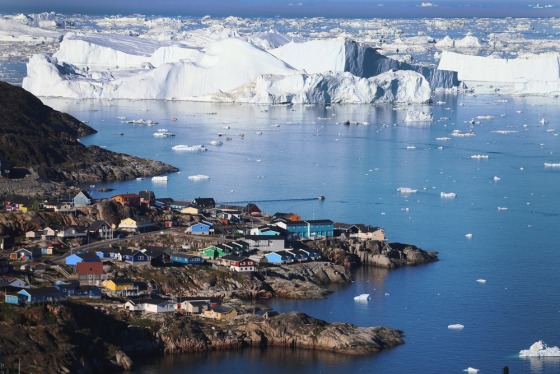- GooglePlus
13 hours ago

By the time today’s preschoolers are babysitting their grandkids, global sea levels are likely to be pushing 2 feet higher than they are now and on the way to topping 8 feet above current levels by the year 2200, according to a new study.
The finding stems from geologic evidence that allowed scientists to tease apart a natural background pattern of how fast and how high sea levels rose as ice ages came and went over the past 2 million years.
Today’s pace of sea level rise is about twice as fast compared to historical standards, the team concluded. Going forward, seas will be pushed higher as rising temperatures force the great ice sheets in Greenland and Antarctica to disintegrate, glaciers around the world to retreat toward mountaintops, and warming ocean waters to expand, the study notes.
“We have awoken a sleeping giant,” Eelco Rohling, a climate scientist at the Australian National University in Canberra, told NBC News in an email. “He is now here to stay.” To stand a chance at halting the rise and preserving today’s coastal cities, he added, “We must virtually immediately take measures of carbon reduction.”
Sleeping giant
The sleeping giant is the loss of ice in Greenland and Antarctica, a process that is slow to start and slow to stop. “We cannot expect that, once moving, big ice masses will screech to a halt,” he explained. “So we better get used to sea level rising, and rising increasingly quickly.”
The rise won’t stop until the seas are about 25 to 30 feet higher than they are today. And that’s assuming atmospheric concentrations of the greenhouse gas carbon dioxide stabilize at around 400 parts per million, a milestone that was crossed in May for the first time in more than 3 million years.
The finding, reported this week in the journal Scientific Reports, is consistent with the amount of sea level rise the United Nations’ Intergovernmental Panel on Climate Change said is likely under a so-called business-as-usual scenario where no action is taken to curb global greenhouse gas emissions.
“The study confirms, from a geological perspective, that our current greenhouse gas emissions are committing our planet to a sea level rise of several meters,” Stefan Rahmstorf, an expert on sea level rise at the Potsdam Institute for Climate Impact Research in Germany, told NBC News in an email. He was not involved with the new study.
‘Normal’ response
Rohling, who studies the geological records of ancient climates, and colleagues, compared their data to historical tide-gauge and satellite observations since coal-powered machinery revolutionized industry in the 18th century.
They found that the current rate of rise is about two times faster than it was during any other period between ice ages, known as interglacials. However, variables that force temperatures higher, such as greenhouse gases, are increasing 10 times faster today than at any time prior to the industrial revolution.
“It is not a given that” the faster rise of greenhouse gas emissions “must result in a faster response of sea level rise because ice sheets are very slow,” Rohling explained. “One could easily imagine that the processes of ice decay would limit how fast sea level rise can take place, no matter how fast the” greenhouse gases increase.
In fact, the current pace of sea level rise is on the high end of “normal,” given what is known about the physical processes that govern the loss of ice in Greenland and Antarctica, the team found.
“This is interesting, because that might indicate that we understand ice physics well enough, and that we do not yet have to start thinking about processes that we don’t understand, or even know about,” Rohling said.
Such processes could, for example, be the disintegration of the East Antarctic Ice Sheet, which is currently stable. Several studies indicate that the ice there could disappear when atmospheric carbon dioxide concentrations reach 1,000 parts per million. If that happens, Rohling noted, “then all bets are off.”
John Roach is a contributing writer for NBC News. To learn more about him, visit his website.
